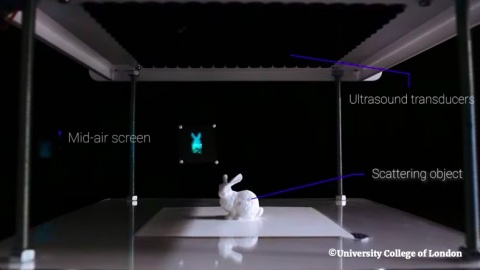-
Team TechTree
10:40 23rd Jun, 2022
Researchers use Sound Waves for Holograms of the Future | TechTree.com
Researchers use Sound Waves for Holograms of the Future
The experiments were conducted by scientists at the University College of London
Researchers at the University College of London have developed a new way to keep objects hanging in the air (levitation) using sound waves. What's new about this effort is that they continue to levitate even in the presence of other objects around the levitation path.

Though the experiment may not appear to be a big step forward, experts believe that this could well change the way holograms are created and used by the industry. In a paper published by the Science Advances journal, the team of researchers have described their experiment as a self-correcting levitation system.
In previous efforts at levitation, it was proved that objects could be levitated by firing sound waves at them. However, it was found that these objects fell to the ground when there was some form of interference in the sound wave patterns, such as the presence of another object located within the field.
This phenomenon was explained as a regular one, given that sound waves are just air particles moving together in a certain pattern and the probability of the pattern getting disturbed by an external influence always existed. With the latest research, the team has come up with new features that take care of this challenge.
Here's how they went about it. The researchers enhanced the number of speakers used for the project, which had started with 256. They added additional software to control each of the speakers and arranged them in a grid with objects getting levitated via specifically shaped sound waves.
By programming the speakers in a specific fashion, the team was able to get the system to work cohesively to keep the move above the grid and hanging in the air even after they placed other objects within the field. In case some sound waves got blocked by the extra object, others were redirected to take their place thus keeping the levitation string unbroken.
The team thereafter added further proof of its viability by testing it using a 3D-printed whiterabbit as an interference object. When other objects were levitated around the rabbit without caring for the latter's location, they continued to stay above the ground and responded to the air waves and their movement.
In fact, in one of the experiments (watch the video here), the team levitated beads around the rabbit that formed itself into a flying butterfly while in another, a piece of clear fabric was levitated. They also moved around a single droplet of water over a glass, thus proving that their system could work even when the interfering object was a glass of water.
For now, the team is proposing that the new experiment be used for demonstrations in museums and in the ad world. The next phase involves handling multiple interfering objects at the same time, the team says.
TAGS: hologram, levitation
- DRIFE Begins Operations in Namma Bengaluru
- Sevenaire launches ‘NEPTUNE’ – 24W Portable Speaker with RGB LED Lights
- Inbase launches ‘Urban Q1 Pro’ TWS Earbuds with Smart Touch control in India
- Airtel announces Rs 6000 cashback on purchase of smartphones from leading brands
- 78% of Indians are saving to spend during the festive season and 72% will splurge on gadgets & electronics
- 5 Tips For Buying A TV This Festive Season
- Facebook launches its largest creator education program in India
- 5 educational tech toys for young and aspiring engineers
- Mid-range smartphones emerge as customer favourites this festive season, reveals Amazon survey
- COLORFUL Launches Onebot M24A1 AIO PC for Professionals







TECHTREE